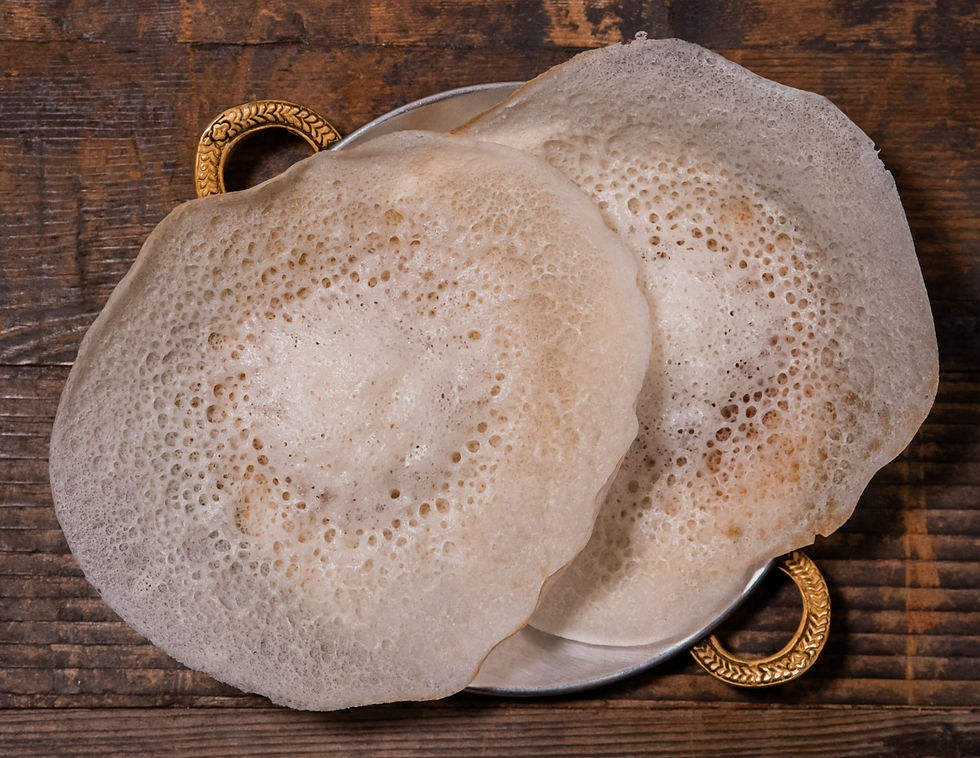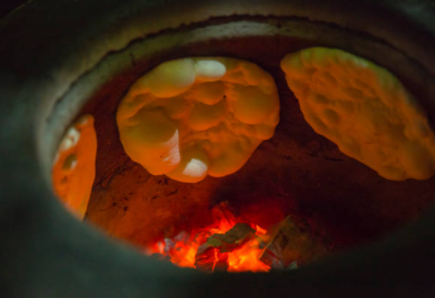Types of Indian breads
- themangotree
- Aug 15, 2021
- 6 min read
Updated: Nov 12, 2024
Fried on a Tava, steamed to perfection or baked on the clay walls of a Tandoor oven, you’ll realise that India’s diversity can be expressed through its basket of warm breads. With more than 30 types of Indian breads, each staple boasts a unique composition and cooking method. Crispy, flakey, moist, fluffy or flat, the breads all have one thing in common - they sure soak up glorious curries!

Tawa and Tandoor
Before we learn about Indian Breads, we must appreciate the different cooking tools used. It’s difficult to miss the conspicuous Tawa or Tandoor in an Indian kitchen. These are the two most common ways to cook Indian breads. A Tawa (or Tava) is a flat cast iron griddle typically used to make flatbreads. A Tandoor is a clay oven fuelled by burning charcoal or wood, and is typically used to make North Indian breads.
While each bread is usually paired with their featured accompanying condiments, at The Mango Tree, we give you the freedom to be adventurous. Be creative by mixing and matching both our North and South Indian breads with our mouthwatering curries. Best of all, you can have them at any time of the day. Here are 8 Indian breads available at The Mango Tree Indian Coastal Restaurant.
#1 Appam

Think of Appam as bowl-shaped pancakes. Gluten-free and vegan, this South Indian delicacy is made from rice flour fermented overnight and can be enjoyed at any time of the day. It has a distinct texture and look - white, fluffy and soft in the middle, with crispy golden-brown laces around its edges.
Appam and Ishtu are a perfect combination! Other popular dishes at The Mango Tree that complement Appam are Avial, Mango Mapas and Erachi Ularthiyathu. Just like Idiyappam, Appams also go well with sweet alternatives and can even simply be enjoyed with coconut milk and orange sugar. There’s no right or wrong - some of our customers even enjoy Appams with our mildly spiced and sweet Paneer Makhani. Who says Appams can only be enjoyed with South Indian curries?
One important point to note - Appams should be consumed fresh because they can lose their subtle yet distinct taste once cooled down. So dine in to have your Appams warm - savour its aroma and dip its fluffy goodness into a bowl of spiced Ishtu!
#2 Tava Dosa

Dosa (commonly known as Thosai in Singapore) is an extremely thin and lightly fried pancake. As its name suggests, it is thinly spread and fried on a flaming hot Tawa. Made out of fermented rice and Urad Dal (lentils), it has a savoury flavour and goes well with chutneys and curries. This South Indian delicacy is most commonly found in Andhra Pradesh, Tamil Nadu, Kerala and Karnataka.
The most popular combination is to have Dosa with Sambar and coconut chutney - simply a match made in heaven. However, do not be surprised to see our customers digging into their Dosas with our North Indian curries as well. Find out just how versatile the Dosa can be and enjoy it in more ways than one at The Mango Tree!
#3 Kerala Parotta (Paratha)

Kerala Parotta (Paratha) is a flaky, crispy layered flatbread that is both sweet and savoury. It is believed that the Singapore Roti Prata we love can be traced back to the Parotta - a South Indian favourite which originated from Kerala, Tamil Nadu and even Sri Lanka.
Made from flour, the Parotta’s delicate crisps melt in your mouth as you peel layer by layer. A quick dive behind the scenes will explain the beauty of its flaky nature. First, the dough is flattened and cut into strips. Then the dough is repeatedly slapped and stretched before it is folded into layers. The layered strips are then rolled together and flattened again to create a spiral pancake with multiple layers. When cooked on a flaming hot Tawa, the crumbly flakes gradually appear even more distinctly as they become golden brown.
While its layered flakes are similar to the North Indian Lachha Paratha, they have their differences. Unlike Lachha Paratha, Kerala Parotta is made with maida flour (plain flour) and the result is a silkier and doughier flatbread. Perfect with savoury curries, be warned that the Parotta is highly addictive!
#4 Idiyappam

Popularly known as ‘String Hoppers’ or ‘Noolappam’, Idiyappam is a textured staple made from rice, flour, salt and water. Commonly found in Kerala, Tamil Nadu and also Sri Lanka, the thin strands of rice noodles are intertwined and steamed to perfection to form this unique South Indian delicacy.
Prepared without any spices, Idiyappams have a neutral flavour and serve as a great base with any savoury or sweet condiments. Similar to Appams, you can have them sweet for breakfast with sugar and coconut milk; a pinch of fresh grated coconut; or with any savoury spiced-curry. The best of both worlds!
#5 Naan

Let’s give a special mention to one of North India’s most loved bread - the Naan. No North Indian meal is complete without Naan - a flour flatbread cooked to crisp yet doughy perfection in a big cylindrical clay oven, known as the Tandoor. Milk is usually used instead of water to give the Naan its extra softness. Naan serves as the perfect accompaniment as its fluffy texture soaks up the gravy from curries while its subtle smoky flavour also makes it a great pairing with dry dishes, such as tandoori chicken.

Many variations of Naan exist, the most popular being Butter Naan, Garlic Naan and Cheese Naan. Though The Mango Tree serves up authentic Naan fresh from the Tandoor, we couldn't resist dabbling in some experimental cooking and adding our own version of Mango Naan to our menu. This sweet treat is one of a kind and appeals to the palates of children and foodies who like to pair sweet with savoury flavours.
With that said, the Naan is so versatile you can even pair it with our coastal dishes. You will frequently notice our customers pick and choose between different Naan variations and South Indian dishes like Kerala Mutton, Chicken Mapas and Prawn Balchao. You have to try it for yourself!
#6 Kulcha

Kulcha is a North Indian mildly leavened flatbread that is most famous in the Punjab region. Considered to be a variant of Naan, Kulcha is usually made with maida flour (plain flour) and slapped onto the walls of a burning Tandoor clay oven. So what makes the Kulcha so unique then? The answer is in its glorious stuffing.
Kulchas are filled with a generous amount of stuffing. While Kulcha is not as soft or chewy as Naan, it has a more crispy and spiced flavour. At The Mango Tree, we serve Onion Kulcha stuffed with our unique blend of spices, fresh coriander and finely chopped red onions. Baked with a charred smoky flavour and drizzled with butter, you will see that this savoury bread can even be enjoyed on its own!
#7 Roti

Roti is an unleavened flatbread made of atta flour (whole-wheat flour). A healthier choice and low in calories, Roti is light and prepared without any filling. While South Indians commonly eat rice as a part of their staple diet, Roti or Chapati is a staple in any North Indian household. Often confused with Chapati (a thinner and softer version of Roti), Roti is typically cooked on a Tawa.
However, at The Mango Tree, we serve Tandoori Roti. Instead of cooking our Roti on a hot Tava, they are roasted at temperatures as high as 480 degrees Celsius in our Tandoor clay oven and this makes our Tandoori Roti crispier. With a hint of charred crisps, many enjoy its subtle smoky flavour. An extremely versatile bread, Roti can be enjoyed with all kinds of North and South Indian curries and even dry preparations - you name it!
#8 Lachha Paratha

Also made with atta flour (whole-wheat flour), Lachha Paratha is a crispy multi-layered flatbread. The popular bread got its name from the Punjabi word “lachha” which means “ring”. While Lachha Parathas can be grilled on a Tawa or baked in a Tandoor, at The Mango Tree, we cook our Lachha Paratha the traditional way in a Tandoor to give it a crispy and smoky flavour.
Lachha Paratha looks similar to the Kerala Parotta because of its visible flaky layers. However, upon a closer look, you will notice the slight difference in their colours as Lachha Paratha is made of atta flour and the latter, maida flour. Unlike the Parotta which gets its flakiness from slapping and stretching its dough, Lachha Paratha obtains its layers from a series of layering and folding with oil (or ghee) and flour. With variations on how to form the intricate layers in the Paratha dough, technique is everything. A perfect Lachha Paratha begins with how the rings are folded.
Drizzled with sinful melted butter and served hot from the Tandoor, Lachha Paratha goes amazingly well with both North and South Indian dishes.
Visit The Mango Tree Indian Coastal Restaurant and taste the wonderful diversity of Indian cuisine for yourself. View our menu.





Comments